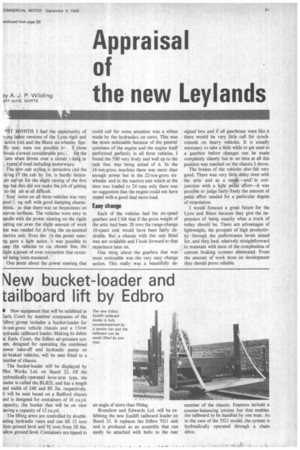Appraisal of the new Leylands
Page 67

If you've noticed an error in this article please click here to report it so we can fix it.
Dy A. J. P. Wilding A echE. MIRTE
'ST MONTH I had the opportunity of laden versions of the Lynx rigid and active t nit and the Bison six-wheeler. Silt ific test; were not possible to 11 three hAssis s towed considerable pro,.. fix the lure wiien driven over a circuit, t nking in types of road including motorways.
The new cab styling is attractive and the lit ing .cf the cab by 5in. is hardly noticeole exc. Tit for the slight raising of the first tep but this did not make the job of getting Ao the :ab at all difficult.
Sus r asion on all three vehicles was very ;ood . ng soft with good damping characeristic _ so that there was no bounciness on meven surfaces. The vehicles were easy to iandle with the power steering on the rigids atting out even the slight amount of work hat was needed for cL4ving the un-assisted ractive unit. Even tho !..h the power steerng gave a light actior it was possible to Leep the vehicles to tat 'chosen line, the light a.nount of over correction that occured being soon mastered.
One point about the power steering that could call for some attention was a whine made by the hydraulics on turns. This was the more noticeable because of the general quietness of the engine and the engine itself performed perfectly in all three vehicles. I found the 500 very lively and well up to the task that was being asked of it. In the 16-ton-gross machine there was more than enough power but in the 22-ton-gross sixwheeler and in the tractive unit which at the time was loaded to 24 tons only there was no suggestion that the engine could not have coped with a good deal more load.
Easy change
Each of the vehicles had the six-speed gearbox and I felt that if the gross weight of the artic had been 28 tons the range-change 10-speed unit would have been fairly desirable. But a chassis with this unit fitted was not available and I look forward to that experience later on.
One thing about the gearbox that was most noticeable was the very easy change action. This really was a beautifully de
signed box and if all gearboxes were like it there would be very little call for synchromesh on heavy vehicles. It is usually necessary to take a little while to get used to a gearbox before changes can be made completely silently but in no time at all this position was reached on the chassis I drove.
The brakes of the vehicles also felt very good. There was very little delay even with the artic and as a result—and in conjunction with a light pedal effort—it was possible to judge fairly finely the amount of pedal effort needed for a particular degree of retardation.
I would forecast a great future for the Lynx and Bison because they give the impression of being exactly what a truck of today should be. There are advantages of lightweight, the prospect of high productivity through the performance levels aimed for, and they look relatively straightforward to maintain with most of the complexities of current braking systems eliminated. From the amount of work done on development they should prove reliable.










































































































































